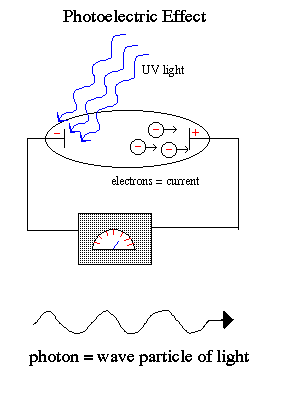
An unusual phenomenon was discovered in the early 1900's. If a beam of light is pointed at the negative end of a pair of charged plates, a current flow is measured. A current is simply a flow of electrons in a metal, such as a wire. Thus, the beam of light must be liberating electrons from one metal plate, which are attracted to the other plate by electrostatic forces. This results in a current flow.

In classical physics, one would expect the current flow to be proportional to the strength of the beam of light (more light = more electrons liberated = more current). However, the observed phenomenon was that the current flow was basically constant with light strength, yet varied strong with the wavelength of light such that there was a sharp cutoff and no current flow for long wavelengths.
Einstein successful explained the photoelectric effect within the context of the new physics of the time, quantum physics. In his scientific paper, he showed that light was made of packets of energy quantum called photons. Each photon carries a specific energy related to its wavelength, such that photons of short wavelength (blue light) carry more energy than long wavelength (red light) photons. To release an electron from a metal plate required a minimal energy which could only be transfered by a photon of energy equal or greater than that minimal threshold energy (i.e. the wavelength of the light had to be a sufficiently short). Each photon of blue light released an electron. But all red photons were too weak. The result is no matter how much red light was shown on the metal plate, there was no current.
The photoelectric earned Einstein the Nobel Prize, and introduced the term ``photon'' of light into our terminology.
Excerpt from the Encyclopedia Britannica without permission.